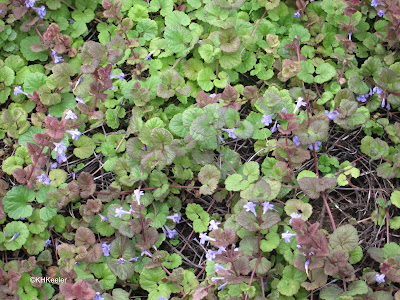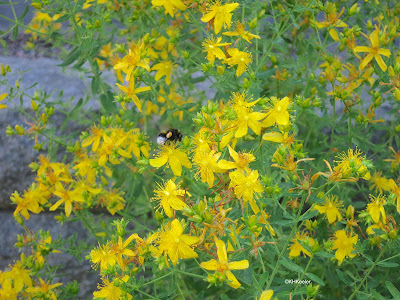How do I know what I read is accurate?
 |
| yellow toadflax |
And that's what's bothering me today. When are the people who I quote accurate and when am I repeating something doubtful?
My first approach for getting it right is to evaluate the sources and quote only the best ones. The best ones will list their sources and will get the details exactly right (in botany, that's often the plant names). If the publisher of the book is well-known, that generally indicates a better article, though some fine books are self-published. Meanwhile, the internet has articles that range from ones written by someone who has studied the subject for 20 years to authors who have barely started learning about the subject. Sometimes that is obvious, sometimes it isn't.
Bad information can be because the author doesn't know enough about the subject to spot problems, does sloppy work, or is repeating an inaccurate source.
What was clear to me researching yellow toadflax was that there were (are) a handful of sources to which most people refer when they write about a particular plant. Gerard and Culpeper wrote books about plants in England in the 17th century, covering several hundred of the most important plants. Grieve in 1933 wrote a two-volume encyclopedia of medicinal plants. These historical sources intended to be accurate, but what they wrote might not be correct in 2022. When quoted for historical uses or colorful stories, they are good sources. For valid information on medicinal uses, names, and distributions, a 21st century reference is needed.
 |
| ground ivy, Glecoma hederacea. Historical sources call it alehof. Lots of people call it creeping Charlie. |
All across the 20th century, people periodically published books reporting plant lore. I have, for example, Who Named the Daisy?Who Named The Rose?; Scott Cunningham's Encylopedia of Magical Herbs; Cursing the Basil; Old Time Herbs for Northern Gardens; and Garden Flower Folklore. There are comparable articles online; in fact, most plant descriptions and blogs about plants fall into this group, because we are writing for a popular rather than expert audience so include personal anectdotes and don't run it past peer review before uploading. These are full of good stuff, but who were their sources and is the information accurate?
It is easy to trust primary sources. An example of that for folklore is Oxford's Dictionary of Folklore. It is a compilation of interviews with people in the U.K., just quoting what they said about a long list of plants. But most folklore books, like those above, compile information from many places and rarely say where it came from. For the most part, with folklore, I just want a cool quote "A bit of flax in the shoe wards off poverty," (Cunningham p. 105), but I can't check that quote for accuracy in the original or go to the source to see if they meant flax leaves or flax flowers.
 |
| common flax Linum usitatissimum in the Gustaf Vasa Museum in Stockholm, Sweden |
A few weeks ago I quoted Durant's Who Named the Daisy? Who Named the Rose? and then discovered her source was wrong. I like Who Named the Daisy? Who Named the Rose? subtitled "A roving dictionary of North American wild flowers." Copyrighted 1976, it is a collection of stories about the history of familiar plants that reads like it was carefully written. She wrote that Dr. John Darlington reported that a Welshman named Ranstead brought toadflax to Philadelphia, leading to the common name ransteads for yellow toadflax. I didn't try to look it up. Later, I wanted more detail and went hunting for John Darlington in Google Scholar. And found nothing. I did find an 1847 book titled Agricultural Botany by William Darlington (physician, botanist and politician, of Chester County, PA 1782-1863 according to Wikipedia) link. The information about Ranstead in Agricultural Botany is the same as in Durant, but the Darlington author is different. Furthermore, Agricultural Botany says the information came originally from "Mr. Watson in his annals of Philadelphia." J. F. Watson in his Annals of Philadelphia (digitized, online, searchable!) says that yellow toadflax was introduced from Wales, as a garden flower, by a Mr. Ranstead link, so that's a solid source of the story. Durant's Darlington was "Dr. John Darlington (1782-1836), who was a bank president in West Chester, Pennsylvania and a dedicated botanist," It looks like Durant made the relatively minor error of writing John Darlington when she meant William. But I propagated her misinformation. I try very hard not to do that.
 |
| ranstead |
Teachers do tell us to check our references and find the source of the quote, not just the quote. When I do that, too often I find some, usually minor, mistake. Quoting or borrowing the information and paraphrasing without checking the accuracy of the statements is very easily done. You don't have to read very many articles on the internet on the same topic to see the same things repeated over and over. (It happens in printed works too, but it is not as easy to pull up ten descriptions from books as from the web.) If they are accurate, then that is a good result. But if someone quotable gets something wrong, misinformation gets sent all over.
The conclusion I'm drawing from this is that it is worthwhile to check the sources of your sources. If your sources don't provide their sources, hunt on until you find some writer who does say where the information came from. That quickly gets very time-consuming, so decide where accuracy is needed. I wanted to get the introducion of toadflax to the U.S. and the explanation of its name ranstead right, so it was worth looking up. Cunningham in the Encyclopedia of Magical Herbs says "toadflax is used as an amulet to keep evil from the wearer." For a general blog on toadflax, I don't need to find out who said that. (Somewhere a writer wrote of toadflax used as an amulet, because Cunningham didn't make it up.) The reverse might be true of an article on plants used as amulets against evil; I would want specifics on the folklore and could be pretty general on toadflax's names and range.
Lots of what is printed, both in books and on the internet, is flawed. Some because it was flawed when it was written, some because knowledge (of history, of science) has rendered it obsolete. Do the best you can to sort through it. Notice inconsistencies. Check what you read against current authoritative sources, if you can. Most of our inaccuracies don't make much difference. For example, a post I saw while writing this said that the Cherokee introduced settlers to St. Johns wort, Hypericum perforatum. Nah, Hypericum perforatum is from Europe and has been used medicinally there for millennia. There are species of Hypericum native to North America that the Cherokee could have recommended. But really, only academics like me care about that kind of error. If you are identifying a plant to eat--that matters and you'd better get it right! For much of the rest of knowledge, the little inaccuracies are no big deal. Just remember that they are there.
 |
| St. Johnswort, Hypericum perforatum |
Comments and corrections welcome.
References and books mentioned:
Culpeper, N. 1652. Culpeper's Complete Herbal (various editions) Online several places. link (accessed 6/11/22)
Cunningham, S. 1984. Scott Cunningham's Encylopedia of Magical Herbs. Llewellyn Publications, St. Paul, MN.
Darlington, W. Wikipedia link (accessed 6/6/22)
Durant, M. B. 1976. Who Named the Daisy?Who Named The Rose? Congdon and Weed, Inc., New York, NY.
Gerard, J. 1636. The Herbal. variously reprinted. Online link (accessed 6/11/22)
Grieve, M. 1971. A Modern Herbal. (Originally published 1933). Dover Publishers, New York, N.Y.
Kamm, M. W. 1971. Old Time Herbs for Northern Gardens. (originally published 1938). Dover Publications, New York.
Martin, L.C. 1987. Garden Flower Folklore. Globe Pequot Press, Chester,CT.
Rich, V. A. 1998. Cursing the Basil and other Folklore of the Garden. Horsdahl and Schubart, Publishers. Victoria, B.C. Canada.
Stone, A. B. 2002. St. John's Wort. Mother Earth Living link (accessed 6/6/22)
Vickery, R. 1995. Oxford Dictionary of Plant Lore. Oxford University Press. London.
Watson, J. F. 1870. Annals of Philadelphia and Pennsylvania, in the olden time; being a collection of memoirs, anecdotes, and incidents of the city and its inhabitants and of the earliest settlements of the inland part of Pennsylvania, from the days of the founders. Online at Making of America digital library link (Accessed 6/6/22).
Kathy Keeler, A Wandering Botanist
More at awanderingbotanist.com
Join me on Facebook: https://www.facebook.com/AWanderingBotanist
Yes. This. I first noticed this when writing documentation for Soapmaking. The same story was repeated over and over again so I dug in and found it was repudiated by a very reputable source. I never did find the beginning of the story.
ReplyDeleteI really notice it in the blogs of the "influencer" type. They just wholesale swipe from each other.
I appreciate your dedication to veracity.